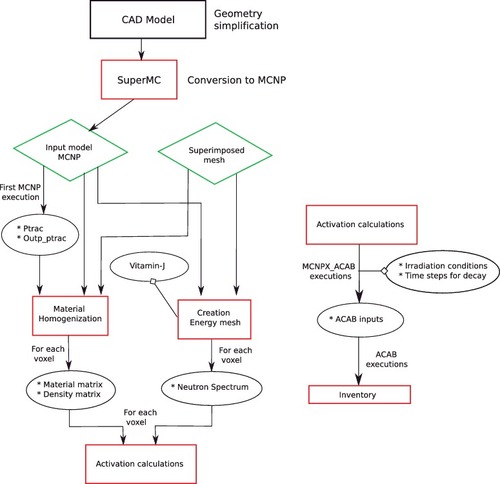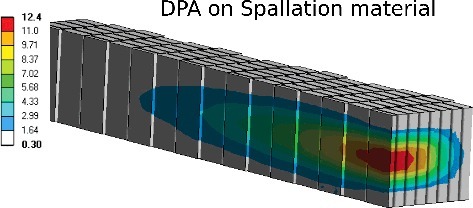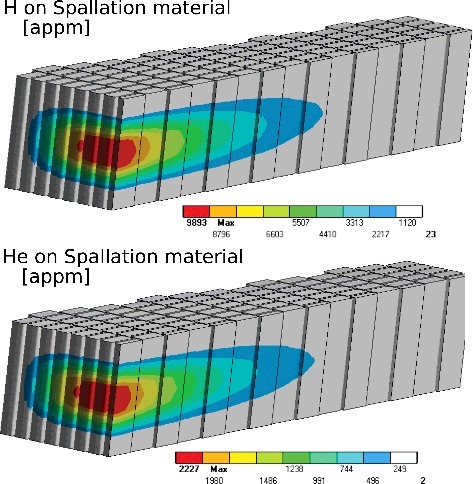 ?Mathematical formulae have been encoded as MathML and are displayed in this HTML version using MathJax in order to improve their display. Uncheck the box to turn MathJax off. This feature requires Javascript. Click on a formula to zoom.
?Mathematical formulae have been encoded as MathML and are displayed in this HTML version using MathJax in order to improve their display. Uncheck the box to turn MathJax off. This feature requires Javascript. Click on a formula to zoom.ABSTRACT
The details concerning the generation and accumulation of radionuclides produced by spallation reactions within the neutron generation target to be installed at the European Spallation Source are described. The resulting radiation damage for the target tungsten blocks constituents as well as the target encasing is evaluated and explicit results are given for the effects of knock-on atoms as well as those resulting from the accumulation of light and volatile hydrogen and helium isotopes resulting from spallation reactions. Their effects on the mechanical properties are discussed on the light of available experimental data and, on this basis, an estimation of the target lifetime is given.
KEYWORDS:
1. Introduction
The European Neutron Spallation Source (ESS) project involves the design, construction and exploitation of a spallation neutron source driven by a proton accelerator which will deliver a 2 GeV proton beam, with a reference power of 5 MW to impinge on a solid rotating target made of tungsten elements and cooled by pressurized helium gas. The basic target concept which has already been briefly described previously [Citation1] consists of a set of tungsten blocks placed inside a wheel encasing of 2.5 m diameter which rotates at some 0.5 Hz in order to distribute the generated heat from incoming protons which reach the target along its radial direction. The neutronics performance of such a target concept as well as some alternative, water-cooled variant has already been published [Citation2–4], so that current efforts concentrate into issues regarding stress and fatigue undergone by target materials, possible radiation damage inflicted to target structural materials and the generation and treatment of a considerable radiotoxic inventory.
The use of pure tungsten as a neutron-generating material was motivated by its excellent neutronic properties as well as by experience accumulated over years of its use at kW range neutron facilities such as the Los Alamos Neutron Science Centre (LANSCE) [Citation5,Citation6] or the ISIS source at the Rutherford Appleton Laboratory [Citation7]. A summary of results related to radiation damage issues up to 2009 from operation of the sources just referred to can be found in [Citation8]. An additional issue to consider is the remarkably high sensitivity of the properties of W to the details of the employed powder metallurgical production processes for the preparation of a given sample [Citation9]. Somewhat special manufacturing routes need to be followed due to the high melting point of this metal Tm = 3422 ± 15 °C which preempts the use of conventional casting methods. In addition, the lack of such details in many of the reports dealing with properties of irradiated specimens makes difficult to draw a consistent picture of the irradiation effects undergone by samples studied so far.
The rationale behind the current efforts stems from the rather scarce direct experimental information available on the lifetime of structural and target components which, under the operating conditions of ESS, may stand proton fluences of the order of 1026 protons m−2 within one year of operation at full power, as it is expected to hold for the target window. The lack of dedicated irradiation facilities which can match such harsh radiation conditions has significantly constrained the available experimental results to those obtained from the study of spent targets and other structural elements. Current efforts such as the planned construction of a small-scale sample irradiation environment at the Spallation Neutron Source (SNS) at the Oak Ridge National Laboratory [Citation10], as well as other future facilities required to sustain the efforts in nuclear fusion [Citation11], may alleviate such a dearth of data in the near future. However, for the time being, the only available tools at our disposal rely on computer simulations carried out using well-tested codes.
The aims of the study here reported on are twofold. On the one hand, to contribute towards a benchmark study onto which the safety issues of the facility may be assessed, and, on the other hand, to provide some data which may serve to build estimates of the target lifetime, determine the frequency of remote handling and other cost-related issues.
In principle, one expects that the main factors limiting the target lifetime will have to do with radiation damage effects generated from nuclear reactions taking place within the target material. Such processes comprise the generation of radionuclides from nuclear cascades which lead to the generation of heat, material-related issues due to embrittlement from accumulation of hydrogen and helium isotopes and material damage due to energy deposition leading to accumulation of crystal lattice defects and vacancies, a quantity which is usually measured in terms of displacements per atom (dpa). Here, we report on estimations of the radionuclide inventory as well as on the estimated damage to the tungsten target elements as well as to the stainless steel structure which supports them as a result of normal operation cycles of ESS. The importance of carrying out such an exercise with the highest reasonably achievable accuracy as far as safety issues are concerned, stands from previous accounts which predict the radioactivity generated in the target to be of comparable magnitude to that of a neutron-generating research reactor [Citation12]. Also, particular attention needs to be paced to the generation of some nuclides able to diffuse out of containment in case of accident as well as due to the action of fast neutrons.
The results reported here constitute one part of the design effort which has led to a final design concept [Citation13] at present being manufactured after approval by the relevant bodies.
2. Design and modeling tools
The ESS target elements are 10 × 30 × 80 mm tungsten parallelepipeds (bricks) which stand on a steel support, referred to as the cassette. The spallation material elements are distributed in a cross-flow configuration as shown in enabling the coolant to circulate along the voids left between adjacent bricks to efficiently remove the nuclear heat. The target manifold composed by 36 of those cassettes. Each of these comprises 186 tungsten elements which are placed in a configuration which avoids a free proton to cross the target without interacting with the spallation material. The incoming and outgoing coolant flows travel along the room left between the wheel ribs and the target vessel.
Figure 1. A schematic display of the target geometry. The target wheel element is shown in the upper frame. The lower frame depicts a cross section of the wheel and a snapshot displaying the arrangement of the tungsten blocks.
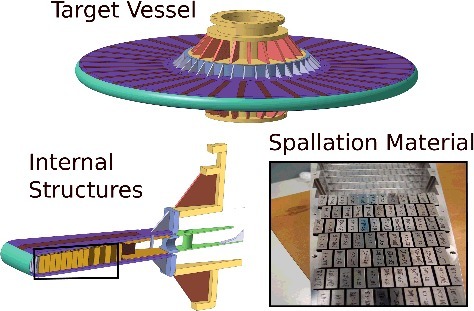
As a consequence of preliminary computational fluid dynamics (CFD) studies, a somewhat modified design of the spallation material pieces was adopted in which the sharp edges of the individual W blocks are rounded along the direction of the He flow thus resulting on rounded surfaces having 1 mm radius. The net effect of such a modification is the decrease of the velocity of He flow from 99 to 76 m s−1. The temperature of the spallation material pieces is however kept below a time-averaged value of 367 °C which is achieved by addition of a row of hollow stainless steel tubes facing the proton beam [Citation1].
The calculations reported here have been carried out following a computational strategy, the schematics of which is shown in . Its first step involves the transformation of the CAD model into a simplified version adequate for input to MCNPX/6 [Citation14] (Monte Carlo N-Particle eXtended) calculations, which is achieved by means of SuperCAM [Citation15]. Once the alluded transformation is applied, a new mesh is superposed where the target elements are represented by a homogeneous continuum with a given average density. Neutron spectra are then evaluated within each mesh cell and, finally, the inventory of spallation products is calculated using the HTAPE3X preprocessor [Citation14] which, in turn generates input data to the code evaluating neutron transmutation and activation calculations. The product inventory is finally evaluated within every discrete volume element (voxel).
Particle transport processes are simulated by means of the MCNPX/6 code for which an adequate mesh had to be developed. The MNCP model explicitly includes the detailed geometry for just one of the target sectors while a simplified model for the remaining 35 elements is represented by a homogeneous mixture of helium and tungsten retaining the same average density as the real material. The employed values for the most relevant MCNP parameters correspond to a target density of 16.1 g cm−3 and a target volume of 1.91 × 105 cm3. In terms of equivalent cylinders, the target would be contained within two cylinders of radii 77 and 125 cm, respectively, and a height of 8 cm.
A comparison of the model used to represent the target module for MCNP and those mesh discretizations used in calculations of activation processes as well as those used for the neutron flux simulations is provided by .
Figure 3. A graphical comparison of MCNP model (shown at the left frame), the mesh employed for the activation calculations is depicted in the center frame and that used in the neutron flux calculations is shown by the rightmost frame.
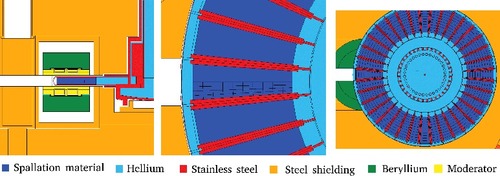
The MCNP code employs physics models for neutrons with energies above 55 MeV and for protons for all energy ranges. In this respect, it is worth recalling that available accurate cross-section data are limited below the alluded energy cut-off. For energies above such value, one needs to recourse to intra-nuclear cascade models. These are introduced as a continuous source of isotopes. The selection of the CEM03 model [Citation16] was favored since it has been shown to yield a more complete production spectrum than other models such as Bertini and is also known to provide more accurate estimates for helium and hydrogen gas production than other computational schemes such as INCL [Citation10]. In addition, CEM03 is significantly computationally more efficient than INCL at the expense of some underestimation of the production of light isotopes having masses within 6 and 35.
Several tests on the predictive capability of the available approaches have been published [Citation17] which although limited for incident proton energies below 1 GeV enable to get some comparisons at least at the semi-quantitative level by means of linear extrapolations. In general terms, the calculations rely on approximate models to simulate the nuclear processes taking place within a proton-struck nucleus and have been tested against experimental data in a few cases where measured data is available. In general terms, the approaches available nowadays regarding quantities such as total neutron production yield estimates which deviate by 10%–15% [Citation18] from measurements, whatever combination of intra-nuclear cascade and evaporation models are used within MCNPX.
Here, use has been made of the ACAB code [Citation19] to carry out neutron activation and transmutation calculations. In essence, such a software package evaluates the isotope inventory taking into account the relevant decay processes, the input from external sources such as the spallation fragments as well as decay reactions following neutron capture events. Relevant libraries used for the purpose were ENDF/B VII (ENDF is an abbreviation for Evaluated Nuclear Data Files) as well as those provided by developers of the EAF codes ( libraries for neutrons, protons, and deuterons up to 200 MeV, such as EAF-2010, have become available in recent times only) [Citation20].
The proton beam footprint is represented by a nearly rectangular distribution generated by a raster process as described in the ESS specification and a graph of the intensity distribution is shown in . Since our main interest here is the study of the accumulated reaction products, an additional simplification is here introduced so that the neutron flux within a target element is considered to be homogeneously distributed whereas the generation of spallation fragments is studied with more detail allowing us to map the spatial distribution of spallation products in great detail. All calculations were carried out assuming an incident proton beam with kinetic energy of 2 GeV and 2.5 mA of average current. The calculations here reported on correspond to a yearly operation time of 5000 hours as far as the activation results are concerned, whereas the total damage infringed upon target and structural components is estimated as a result of five years of operation, namely 25,000 hours of operation at full power.
3. Results
3.1. Radiotoxic inventory
As expected, the impinging 2 GeV proton beam has an energy well above the average nuclear binding energy, ≈8 MeV and thus leads to the generation of a hadronic cascade as well as to the emission of high-energy neutrons and other particles. Such reaction products end up depositing substantial thermal energy over a large volume and trigger the generation of secondary spallation fragments which are generally radioactive and neutron deficient with respect to the valley of stability. A rough estimate of the activity that can be expected for a spallation target made of non-fissionable materials yield some 1.87 ×10 16 Bq per milliampere of proton beam.Footnote1so that the use of 2.5 mA beams as specified should yield some 4.67 × 10 16 Bq after a very long irradiation period. Apart from induced radioactivity, spallation processes lead to a significant fraction of the input proton power to be converted into nuclear heat. The expectancy on the basis of available data is that for a beam of 2 GeV, a fraction of some 0.6 will go into heat production for a non-fissionable target material, mostly resulting from spallation products and neutron capture reactions. However, the volume deposition of thermal energy during a pulse train depends on details of the hadron cascade as well as on the incident beam profile and pulse repetition frequency and pulse duration. In this respect, it is worth emphasizing that although one expects that about two-thirds of the generated inventory arise from spallation products and this can be simulated with less detailed tools, the remaining faction will surely arise from capture reactions on W and this makes mandatory to make a pretty accurate estimation of the neutron flux. Otherwise, the results may lead to a substantial underestimation of radionuclides generated by such a route. In consequence, simulations using as many fine details to represent the nuclear reactions as reasonably achievable need to be carried out to yield realistic estimates of quantities such as those above referred to.
The relevant issues concerning the nuclides generated within spallation targets have to deal with the yield of a given isotope as generated by nuclear reactions, its activity, average lifetime, volatility and diffusivity outside target containment. Highly volatile isotopes mostly concern the hydrogen and helium isotopes as well as iodine. The first two categories need to be treated separately due to their potential effects on the target material mechanical properties.
Our estimation of the inventory of radioactive isotopes resulting from spallation processes is listed in which provides the inventory of the generated nuclides for the first 100 s, one day and five years after shutdown. A glance to data listed in the table tells that the dominant activity at shutdown results from 187W, 185W, 181W and 178Ta. Some other isotopes do exhibit a significant activity right after shutdown but their short lifetimes make them to contribute very little to the total activity one day after shutdown. However, there is significant activity for all listed isotopes. On the other hand, the table reveals that the isotope distribution significantly evolves with time and thus elements such as 170Lu and 172Lu become relevant 24 hours after shutdown. Long time after shutdown, the activity will be dominated by 179Ta, 172Lu and 172Hf with significant contributions from tritium and other isotopes such as 60Co and 90Sr now becoming relevant.
Table 1. Table of the main radionuclides generated within the target elements 100 s, a day and after five years of operation
A number of faster decaying radioisotopes not included in the table which need to be taken into account for target maintenance operations are listed in . Such an inventory needs to be taken into consideration for target handling purposes account made of the volatility and toxicity as some of the species there listed.
Table 2. Short-lived nuclides with activity larger than 0.1 GBq and half-lifetimes larger than one hour as generated after one year of operation
The calculated inventory shows that a number of very long-lived but non-fissile isotopes such as 163Ho, 148Gd, 157Tb, 101Rh, 91Nb and 63Ni will contribute to the inventory well beyond five years after shutdown.
The effect of the target rotation in distributing the activity over a relatively large volume is easily gauged by comparison of the figure calculated for a target operating at the nominal beam power and rotation rate which leads to 1.15 × 1012 Bq cm−3 100 second after shutdown and 5000 hours of operation, versus 3.6 × 1013 Bq cm−3 in the case of a target stuck at one fixed position, which thus result in concentration of the radiation load within one of its sectors. The total activity which would correspond to some 2.19 × 10 17 Bq comes to be about one order of magnitude higher than that quoted at the beginning of this section.
The spatial distribution along the target elements of the activity of two of the most relevant radio-nuclides, namely 171Lu and 187W, is displayed in graphs shown in . A glance to such graphs reveals rather distinct patterns of isotope accumulation for both nuclides. The larger activity of 187W is distributed along concentric circles reaching figures of some 1.11 × 1012 Bq cm−3, whereas that for 171Lu which comes to be one order of magnitude smaller is distributed on a far more localized fashion. Such a difference in distribution of both nuclides comes as a consequence of the distinct pathways followed for the generation of such isotopes. In fact, production of 171Lu is mostly a result from proton-induced high-energy spallation reactions and therefore its distribution closely resembles the beam footprint. In contrast, the production of 187W results from low-energy neutron capture reactions and therefore its distribution is far more homogeneous and, in fact, the concentration of such nuclide attains large values within the target surface which comes closer to the reflector-moderator manifold.
Figure 5. Distribution along the target elements of the 187W and171Lu radionuclides after the shutdown.
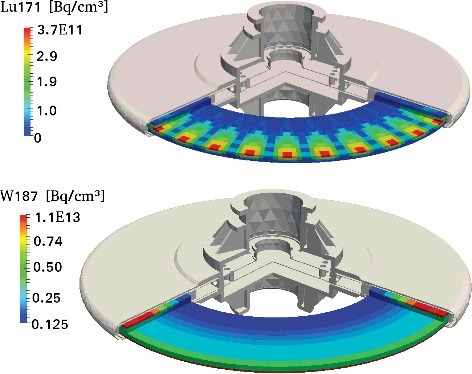
The simulation results can be readily compared with experimental data measured for W targets and proton beams of 0.5 and 12 GeV [Citation17] as well as with estimations carried out for the Chinese Spallation Source [Citation21] calculated for an incident proton energy of 1.6 GeV, and a beam power of 100 kW. Such an exercise yields consistent results for the calculated inventory.
In summary, our results confirm that the estimated inventory will generate significant residual heat which amounts to 27.2 kW. Most of it will arise from 187W and 185W, although heat generated by neutron activation accounts for some 60% of the total heat. As far as the decay rate of such inventory, the current results tell that 100 s right after shutdown, spallation fragments account for some 57% of the total heat while neutrons account for an additional 33%. Some 10 days later, however, radionuclides generated by spallation reactions account for 99% of the total residual heat. As far as the inventory is concerned, most of the generated isotopes will not pose stringent handling problems since they are expected to remain confined within the enclosure. Special care has to be taken, however, with tritium isotopes which apart from being present in the cooling circuits will also be generated by the inventory in the long run. Also, target-handling strategies need to be devised to account for the presence of shorter lived isotopes such as those from strontium or iodine.
3.2. Radiation damage
Radiation effects on the spallation material as well as within the target structural materials are expected on the basis of data already available resulting from the analysis of irradiated materials or from inspection of spent target components [Citation8,Citation22]. The radiation damage effects relevant for the study of a spallation target comprise elastic collisions where an incident proton or neutron transfers energy and momentum to a target atom which can then leave its equilibrium position within the material. In turn, inelastic processes leading to nuclear reactions may lead to the production of H, He and other light isotopes as well as heavier fragments, an issue addressed in previous sections. As far as helium is concerned, its high heat of solution makes it insoluble in W at typical operational temperatures. This will lead the accumulated gas to nucleate gas clusters in the metal matrix which, in turn, can coalesce with each other to form larger and more mobile entities. Such phenomena may affect the fracture strength of target and structural materials which may thus be compromised when these defects reach their grain boundaries. In cases where accumulation of such gas on the grain boundaries becomes substantial, the material strength as well as its thermal conductivity may be significantly reduced, thus leading to operational temperatures higher than expected.
Beam interactions with the target material are known to lead to knock-on atoms if the beam exceeds a threshold energy Td which for tungsten is known to vary within the 50–90 eV range [Citation22,Citation23]. At such energies, the primary knock-on atoms will react with its neighbors leading to a displacement cascade taking place within the picosecond range of times, out of which a defect pattern will evolve. Such defects which can be interstitials or vacancies will become thermally mobile at the temperatures of operation of a spallation source and can in turn trigger defect reactions involving trapping, clustering or recombination processes. The material properties will thus become affected if the net result of such reactions leads to some imbalance in the generation of interstitials and vacancies. These complex processes are generally difficult to quantify in full and a pragmatic approach is usually employed where damage in dpa units is related to the damage cross-section σdamage by
(1)
(1)
where β taken as 0.8 is a constant to compensate for forward scattering in the displacement cascade, φ(t) stands for the particle fluence, and Td is the effective threshold displacement energy and σd is the displacement cross section which represents the energy transmitted to the recoil nucleus in the collision. The evaluation of such effects has been traditionally carried out using the NRT model [Citation24] and it is known to overestimate the damage effects. More recent approaches which make use of use a binary collision approximation supplemented with results from molecular dynamics calculations, referred to as BCA-MD [Citation25], have been shown to provide more accurate results. In fact, total displacement cross sections for W have been compiled by Konobeyev et al. [Citation26] and contrasted versus experimental data for proton energies up to some 1.94 GeV. The average value as calculated by means of the BCA-MD approach yields some 5130 ± 1330 to be compared with an experimental estimate of 4094. Such a comparison serves to set an estimate of the accuracy of the calculations here described if comparison with experimental data would become available.
The evaluation of the accumulated radiation damage requires to consider the combined effects of both incident protons and neutrons generated by different nuclear processes. Since the former hit the target as pulses within a localized region, we have employed a square mesh and the total damage has been distributed over the 36 target sectors. The effects caused by neutron fluxes are somewhat more complex. On the one hand, the region close to the incident proton beam shows a large flux gradient which is basically proportional to the source term. Evaluation of the effects of such neutrons is carried out using a cylindrical mesh with angular divisions of ten degrees which are equivalent to one of the target cassettes, and the total effect is then divided by the number of target sectors. A second region comprises neutrons with lower energies mostly resulting from moderation processes. Such neutrons are distributed following a smoother profile and their effect is evaluated using a cylindrical mesh devoid of angular divisions which enables the flux to be homogenized along the target wheel perimeter. Both contributions are then combined to evaluate the total damage arising from neutron events.
The total damage on the target can thus be written using
(2)
(2)
where the relevant symbols are those defined by Equation (Equation1
(1)
(1) ).
The results from the present calculations show that some 12.5 dpa will be accumulated along the full target lifetime (i.e. expected to be five 5years) at the outermost W blocks, while such quantity goes down to about 0.1 dpa at the innermost sections. By comparison, damage to the target structural element, namely the 316L stainless steel wheel casing, is found to reach values close to 4 dpa which concentrates within a relatively small region which basically coincides with the beam footprint. The results can be compared with estimates made for the SNS target [Citation27] which report values of some 36 dpa for the part of the target hull facing the proton beam window, as well as with results from calculations carried out within the JSNS project [Citation28] which predict a damage of 3.9 dpa for the target vessel corresponding to 5000 MW h. The latter results appear to be in line with estimates for the American second target station at SNS [Citation29] and predict a damage to the solid W target hit by a 466 kW proton beam of 5.41 dpa from proton damage and 5.72 dpa from neutron damage at the target beam window entrance, also for 5000 hours of operation per year, thus making the component able to stand the beam power for some 11 months. The results for the target vessel thus compare favorably with the estimate of 20–33 dpa per full power year estimated for the target hull corresponding to the initial ESS liquid metal target specification [Citation30].
A pictorial view of the distribution of the calculated damage along one of the target sectors, as well as that concerning the stainless steel vessel, is provided in Figures and .
Figure 6. Radiation damage distribution along the spallation material bricks. Calculated data correspond to a displacement threshold energy Td = 80 eV. The region showing the maximal damage corresponds to that close to the proton beam window.
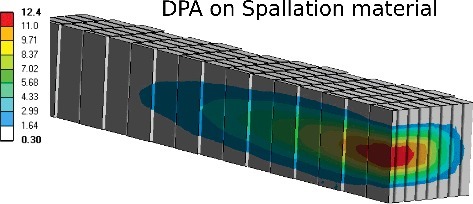
Figure 7. Radiation damage distribution along a cross section of the stainless steel vessel. The employed value for the displacement threshold energy was Td = 40 eV.
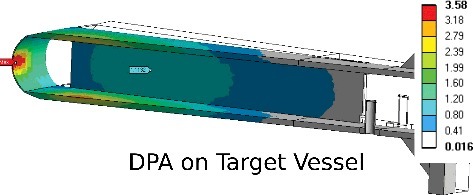
The significance of the calculated dpa values is to be analyzed in the light of the scarce data available. Data from tests at LANSCE [Citation31] seem to be in contrast with previous data from neutron-irradiated samples [Citation22] which report on brittle specimens when the neutron fluences reached 1025 neutrons m−2, which corresponds to a displacement dose of some 0.1 dpa. In addition, those results suggest that the target will operate within the brittle regime after a relatively short time of service.
Within the second class of effects pertaining to transmutation products resulting from nuclear reactions, generation of gaseous elements such as He and H are the most important since, particularly, He is known to affect the material properties of the spallation material event at low concentrations. In fact, He produced in nuclear materials is practically always present under supersaturation conditions and shows a strong tendency to form bubbles which, as mentioned above, if close to grain boundaries may lead to drastic degradation of the mechanical properties of the materials. With respect to the hydrogen produced, metals such as W will dissolve H endothermically leading to the formation of bubbles and also leading to material embrittlement. The relative importance of He and H production effects is usually measured in terms of the He,H/dpa ratios which for existing kW-range spallation sources are typically of the order of 200 [Citation21,Citation22].
Our data shows that the production of hydrogen and helium inside the spallation material as a result of 25,000 hours of operation at nominal power of 5 MW will lead to the accumulation of 10000 appm of H with maximal concentration at the W outermost blocks and the same applies to He isotopes which show maximal concentrations of 2250 appm. displays the detailed distribution of both isotopes alongside one of the target elements.
The results for gas production compare with the estimate of some 4× 103 appm/year for H and about 900 appm/year for He estimates for a static target at FMITS [Citation31].
The expectation at the time of writing is that gas accumulation will lead to a modest swell of some 0.22% in volume [Citation32] of target elements. Such an estimation appears to be consistent with experimental data of neutron-irradiated W [Citation33] if target temperatures do not exceed 400 °C.
Finally, the available reports [Citation10] tell that one should expect a somewhat smaller gas accumulation within stainless steel than that calculated for tungsten which therefore should not be a matter of serious concern.
To summarize, significant damage is expected to be registered by the outermost tungsten blocks situated close to the proton beam entrance. In contrast, structural elements such as the steel wheel casing or the innermost W blocks show bearable dpa values which may be compared to those reported for target structural elements from facilities such as JSNS [Citation28], CSNS [Citation21], or SNS [Citation27] once account is made of the effect or target rotation.
4. Discussion and outlook
The total activity of the radioactive inventory decreases by about one order of magnitude within one day after shutdown and will remain at significant levels for many decades. The activity is mainly due to tungsten, tantalum, lutetium and hafnium isotopes. In addition, there are considerable amounts of low- and medium-activity waste. The total activity becomes comparable to that generated by a 20 MW research reactor after one cycle of operation, a result which matches the case study carried out more than a decade ago for a liquid Hg target [Citation34]. A graphical comparison between the activity of both facility concepts is provided in , a comparison carried out assuming that the ESS target is not replaced along the lifecycle of the facility, and therefore represents the most unfavorable comparison than can be made between the stocks resulting from such two experimental facilities.
Figure 9. A comparison of the estimated activity of the ESS tungsten target after the full lifecycle of the facility with that of a single-core research reactor burning low-enriched 235U with 22% burnup and an operation cycle of 50 days. Data for the latter is reproduced from [Citation34].
![Figure 9. A comparison of the estimated activity of the ESS tungsten target after the full lifecycle of the facility with that of a single-core research reactor burning low-enriched 235U with 22% burnup and an operation cycle of 50 days. Data for the latter is reproduced from [Citation34].](/cms/asset/561d8a31-75c7-432d-8c7e-0e9512c77d9b/tnst_a_1417173_f0009_oc.jpg)
The graph tells that both inventories are of comparable size and that resulting from the ESS target shows a comparatively larger stock of long-lived nuclides. However, to compare both decay patterns, it needs to be remarked the absence of fissile actinides which dominate the waste activity arising from an experimental reactor many years after shutdown and are absent in the tungsten target. In consequence, we estimate that the handling/storage of spent target elements can be performed following protocols already tested at other spallation neutron facilities.
The calculated radiation damage effects for the 5 MW ESS target show that a significant 12.5 dpa will accumulate in the tungsten target after a stable operation along five years. The accuracy of such estimates may vary somewhat depending on the particular physics models employed for the calculation of the cross sections. The CEM03 model used in the present study has been shown to provide comparable estimates for H and He generation in tungsten to that predicted by Bertini and somewhat above those predicted by INCL models [Citation10] at least for energies up to 1.6 GeV. The results at hand tell [Citation21] that the effects of a somewhat higher proton energy can be safely guessed from a linear extrapolation of existing data. The current results are thus consistent with those reported for the CSNS source [Citation21] as well as with estimates derived from other facilities [Citation10,Citation28,Citation29].
The radiation damage data pertaining the target vessel can be compared with experimental results on irradiated specimens [Citation35] which shows that irradiation up to some 3 dpa results in an increase of the yield strength up to some 800 MPa and decreases its ductility. Irradiation up to 4 dpa which is performed using a 800 MeV proton beam with 1 mA current is also expected to lead to a decrease in fracture toughness of about 50%. At any rate, the maximal damage for the target structural element is well below the values usually found in fission reactor components.
Any estimation for the target lifetime will obviously depend upon what will be considered as allowable displacements for W or other structural elements and its effects on the mechanical properties of the materials. The available experimental results [Citation6] suggest, however, that in order to avoid mechanical failures caused by embrittlement, the outermost W blocks should be replaced when damage exceeds some 3–4 dpa. In contrast, with the data at hand, we can take the administrative limit of 10 dpa for stainless steel and from there to infer that the target structural elements may last for a minimum of 10 years of operation. As mentioned in the introductory paragraphs, there is no currently available data measured under conditions comparable to those here explored. Existing data from LANSCE related to compression tests carried out for a W rod after irradiation up to 23.3 dpa at temperatures within 50–270 °C show an increase in tensile strength and a reduction in ductility of the material [Citation31]. More recent data has focused on the ductile-to-brittle transition temperature (DBTT) on pristine W samples [Citation36] and report on transition temperatures within 250–300 °C or 350 °C depending upon metallurgical preparation methods (i.e. hot-rolled or hot-forged samples). Data from mostly fast neutron irradiated samples [Citation37] show that irradiation shifts the ductile-to-brittle transition to higher temperatures as the fluence is increased. More recent results arising from efforts carried out by the JSPS Grant Team [Citation38] to develop ultra-high tough W materials able to stand high beam impact and radiation damage may possibly open a new avenue to make fine grained tungsten materials having four times larger fracture toughness than conventional W.
At any rate, the scarce experimental data available suggest that target failure will result from fracture mechanics issues rather than from loss of mechanical properties such as yield or ultimate tensile stresses. The current target design leads to minimal damage since most of it will be concentrated within the outermost W pieces, the failure of some which could be handled at ease under normal load conditions [Citation1]. However, the behavior of the material under heavy thermal shocks needs to be addressed in detail. In this respect, several accident scenarios have been under study and the results will be given in a separate publication.
With respect to gas accumulation, their impact on target lifetime is difficult to assess at present, also due to the lack of relevant experimental data. In fact, in contrast with the better studied effects of He content up to several 1000 ppm at temperatures up to some 0.45 times the melting point of W as intended to be relevant for structural fusion materials, no such information exists for the low-temperature regime where the spallation facility will operate, with exception made of some studies on bubble formation by interstitial emission. The effects of the generated H gas are even harder to assess since detailed studies on the issue seem to be absent as a consequence of the scarce relevance of such a problem for fission and fusion materials, since their temperatures of operation lead to fast hydrogen diffusion so that rather small concentrations would accumulate within the material.
In summary, the most relevant material issue regarding the long-term stability of the ESS target elements concerns radiation-induced hardening of the spallation material elements which takes place for operation temperatures of some 0.1Tm so that the material will operate under low fracture toughness conditions, thus showing low resistance to crack propagation under tensile stresses. The present results thus suggest that the whole target may last for a maximum of five years under the ESS operation conditions due to cumulative radiation damage effects. The design of diagnostic tools to assess the state of the outermost layers of W blocks seems therefore highly advisable.Footnote2In addition, effects caused by the brittleness of the material, which will lead to fracture surfaces where accumulation of gaseous isotopes may take place [Citation39], constitute an issue which merits a separate study on its own. In this respect, it is worth pointing out that, on the grounds of results from calculations of void migration in fusion materials, the chosen spallation material appears to be more resilient to mechanical failure than others considered as candidates for plasma-facing candidates for nuclear fusion applications [Citation40] .
Finally, it seems worth recalling the need to carry out further studies on the generation of tungsten dust resulting from material fatigue due to the large number of thermal cycles expected to be undergone by a pulsed neutron spallation target.
Acknowledgments
This work has been possible, thanks to the support of the computing infrastructure of the i2BASQUE academic network.
Disclosure statement
No potential conflict of interest was reported by the authors.
Notes
1. Taken from [Citation8,p.268].
2. A development project is currently under development at ESS concerning the design of a diagnostic tool for this purpose. The basic idea is to directly take pictures using the gamma emission from the active elements. The issue is however beyond the scope of the present work and a different research group in charge of it.
References
- Aguilar A, et al. Nucl Instrum Methods. 2017;A856:99.
- Magán M, Terrón S, Thomsen K, et al. Nucl Instrum Methods. 2012;A680(4):61.
- Ghigino A, et al. Nucl Instrum Methods. 2014;A756:73.
- Thomsen K, Heinrich F, Butzek M, et al., Nucl Instrum Methods. 2012;A682:42.
- . In: Brown RD, Wechsler MS, Tschalti C. Garner EA, Henager CH, Igata N. Effects of radiation on materials properties, editors. 13th International Symposium ASTM STP 956. Philadelphia (PA): ASTM; 1987. p. 131 Nelson J, et al. J Nucl Mater. 2012;431:172.
- Malloy SA, et al. J Nucl Mater. 2012;431:140.
- Broome T, et al. Proceedings of 2nd International Workshop on Spallation Materials Technology; Ancona, Italy; 1997. p. 55.
- Filges D, Goldenbaum F. Handbook of spallation research. Weinheim: Wiley-VCH; 2009. Chapter 14; p. 471.
- Gil-Sevillano J, et al. Tungsten data sheets. Reutte: Metallwerk Plaosee GmbH; 1988; Ref. ESS 0066192. Our own assessment on specimens obtained from six different suppliers have shown differences in density up to 5 % and up to 11 % in Young Modulus.
- Lu W, Gallmeier FX, Wendel MW, et al. Proceedings of 3rd International Workshop on Accelerator Radiation Induced Activation (ARIA 15); Knoxville, TN, USA, 2015 Apr 15–17. See also https://public.ornl.gov/neutrons/conf/aria2015/ presentations/ 14%20Activation%20Analysis%20in% 20Steel%20and%20Tungsten%20Samples%20at% 20FMITS.pdf
- Zinkle SJ, Mosslang A, Fusion Eng Des. 2013;88:472; Gonzalez de Vicente, et al. Nucl Fusion. 2017;57:092011.
- Filges D, Goldenbaum F, Lensing B, et al. Proceedings of ICANS-XVI, 16th Meeting on International Collaboration Advanced Neutron Sources; Neuss; 2003 May 12–15; p. 551, ISSN 1433-559X.
- Aguilar A, et al. ESS target. Dec 2016. (Technical design report, Ref. ESS-0058538).
- Goorley T, et al. Nucl Technol. 2012;180(3):298–315; MCNPX users manual, version 2.6.0. 2007.
- Wu Y, FDS Team. CAD-based interface programs for fusion neutron transport simulation. Fusion Eng Des. 2009;84:1987–1992.
- Gudima KK, et al. CEM03.01 and LAQGSM03.01 event generators. Los Alamos National Lab; Mar 2006. (Technical report).
- Asano Y, Kariya H, Mori S, et al. J Phys Soc Japan. 1988;57:2995 Asano Y, Mori S, Noguchi M, et al. J Phys Soc Japan. 1988;54:3734 Broeders CHM, Konobeyev AY. Nucl Instrum Methods. 2005;B234:387 Malyshkin Y, Pshenichnov I, Mishustin I, et al. EPJ Web Conf. 2012;21:10006 Findlay DJS, Skoro GP, Burns GJ, et al. Appl Rad Isotopes. 2017;125:1.
- Leray S, et al. Nucl Instrum Methods. 2006;A562:806.
- Sanz J, Cabellos O, Garcia-Herranz N, ACAB 2008, ACtivation ABacus Code V2008. NEA Data Bank; 2008. (NEA 1839).
- Sublet J-C, et al. CCFE report R (10) 05. 2010.
- Yin W, et al. J Nucl Mater. 2012;431:39; 2010;398:100.
- Ullmaier H, Carsughi F. Nucl Instrum Methods. 1995;B101:406.
- See Am Soc Test Mater. 1989; p. 167.
- Norgett M, Robinson M, Torrens I. Nucl Eng Des. 1975;33:50.
- Boeders CHM, et al. J Nucl Mater. 2005;336:201; ibid. 2005;342:68; K. Vörtler, et al. J Nucl Mater. 2008; 382:24.
- Konobeyev AY, Fischer U, Broeders CHM, et al. Displacement cross-section files for structural materials irradiated with neutrons and protons. International Atomic Energy Agency; August 2009. (Nuclear Data Services, Ref. IAEA-NDS-214).
- Barnett MH, et al. J Nucl Mater. 2001;296:54.
- Harada M, et al. J Nucl Mater. 2005;343:197.
- Remec I, Popova II, Gallmeier FX. Proceedings of 3rd International Workshop on Accelerator Radiation Induced Activation (ARIA?15); Knoxville, TN, USA; Apr 15–17; 2015. See also https://public.ornl.gov/ neutrons/conf/aria2015/presentations/25%20Activation% 20Assessment%20of% 20the%20SNS%20STS.pdf
- Vladimirov P, Mosslang A. J Nucl Mater. 2005;343:205.
- Maloy SA, et al. J Nucl Mater. 2005;343:219.
- European Spallation Source materials handbook. (Ref. ESS 0028465).
- Wiffen FW, J Nucl Mater. 1977;67:119 Matolich J, Nahm H, Moteff I. Scripta Metall. 1974;8:837.
- Moorman R, et al. European spallation source update report. Vol. III. 2003. Chapter 8; p. 8.25.
- Maloy SA, et al. The change in mechanical properties of alloy 718, 304L and 316L stainless steel and AL6061 after irradiation in a high energy proton beam. (Los Alamos National Laboratory Report LA-UR99-4175). http://permalink.lanl.gov/object/tr?what=info:lanl-repo/lareport/LA-UR-99-4175
- Sheng T, Dai Y, Lee Y. J Nucl Mater. 2016;468:348.
- Krautwasser P, Derz H, Kny E. High Temp. High Pressures. 1990;22:25 Steichen JM. J Nucl Mater. 1976;60:13 Gorynin IV, et al. J Nucl Mater. 1992;191–194:421.
- Kawai M, et al. J Nucl Mater. 2012;431:16.
- Dong-Dong P, et al. Chinese Phys. 2016;40:037004.
- Cotrell GA. J Nucl Mater. 2002;302:220.

